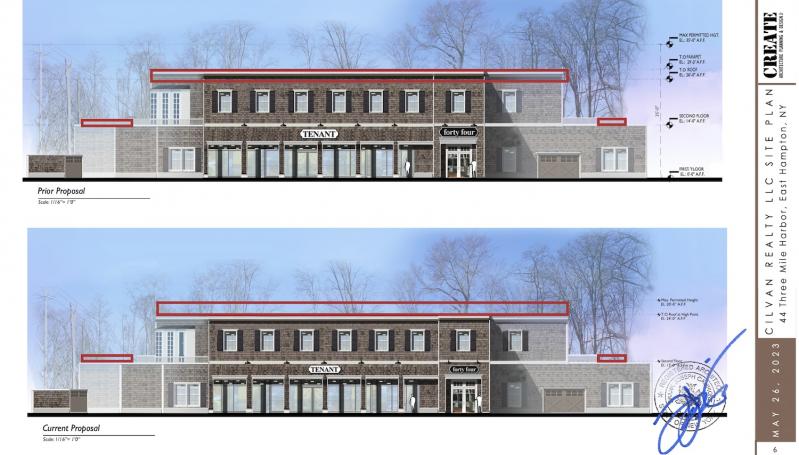While it is clear the building at 44 Three Mile Harbor Road in East Hampton, which for decades operated as a nightclub, will no longer be one, its reincarnation has nonetheless been a show. At a June 7 planning board meeting, members voted to hold a second public hearing on the project, setting the stage for yet another act on the complicated application.
The building has been there forever, or at least before town zoning laws were introduced in the 1950s. Cilvan Realty, the owner, proposes to roughly double its size by adding a second story and basement, while retaining its footprint. (In a May 12 letter to the planning board, after Cilvan asked him to clarify the difference between a “reconstruction” and new construction, Joseph Palermo, the chief building inspector, copied and pasted town code, concluding that “a nonconforming structure can be reconstructed.”)
While it’s unclear who or what will occupy the lower level — it could be a food market or other retail use — upstairs, the plans show four affordable housing units and office space.
Since 2021, Cilvan Realty representatives have appeared before the town’s Architectural Review Board, the Zoning Board of Appeals, and the planning board multiple times. The June 7 meeting was necessary because when reviewing its application after an April 12 public hearing, Cilvan discovered that its proposed building would need a pyramid variance — a fact originally missed by both their architects and the Planning Department.
“Frankly, we all missed the pyramid,” said Ian Calder-Piedmonte, a planning board member, at the meeting.
To avoid having to ask for a new variance, Cilvan changed the building’s design.
“Over all, they have reduced the height of the building by five feet,” said Tina Vavilis LaGarenne, principal planner for the town. The building as redesigned would be 24 feet high. Richard Whalen, Cilvan’s attorney, in a letter to the planning board, said the design change had resulted in a “reduction in the apparent mass of the second floor.”
The main question was whether the changes were enough to necessitate a new public hearing, but that seemed easy. All board members except Michael Hansen said there should be one.
(The need for a traffic study, though, ignited debate. It’s not just the planning board that’s concerned about traffic. At its work session on Tuesday, the East Hampton Town Board heard from a
traffic engineer working on a “corridor
study,” which includes the road in front of Cilvan’s building.)
“There was a honeymoon period where we were so glad to get rid of the nightclub, and now we’re in a different place,” said Randy Parsons, a planning board member. Both a traffic study and another public hearing are necessary, he said, to address the latest changes to the plan.
Louis Cortese, another board member, agreed, citing language from an engineer hired by the town, who had advised that “peak hour traffic projections” for new uses “are extremely high,” and therefore recommended that a site-specific traffic study be conducted.
“This is crystal-clear language that we really need a traffic study,” Mr. Cortese said. “The public wants a study; I think we should listen to them and the consultants.”
Mr. Whalen did not agree. “We’re not going to do a new traffic study,” he stated, recalling that at the April hearing only three members of the public had spoken, “and two asked for a traffic study. That is not exactly an overwhelming demand for it.”
The changes to the project decreased the size of the building and would have no effect on traffic, Mr. Whalen continued. Since the board had previously determined the application was complete, he said, a traffic study was “not something we’d willingly agree to.”
“If we require a public hearing,” said Ian Calder-Piedmonte, a board member, “I’d be okay with not doing a traffic study.” Nonetheless, he said a study “seemed like a good idea at this point.”
“I’m not against it,” said Sharon McCobb, a board member. “I’m wondering if it’s appropriate at this time.”
Samuel Kramer, the board chairman, asked Nancy Marshall, an assistant town attorney who counsels the planning board, if she felt a traffic study was necessary. “I can’t see how anybody will claim that the changes will impact traffic,” she said.
“Theoretically, if 25 people come in and say, ‘I want a traffic study,’ then when we do our final discussion, we’ll have 25 comments saying, ‘traffic study,’ “ said Mr. Kramer, leaving it up to the public to push for the study.
In the end, only Mr. Parsons and Mr. Cortese voted for a traffic study.
In an email afterward, Mr. Whalen said he hoped the board would schedule the public hearing on Wednesday, when it next meets, and hold it on July 26. Whenever the hearing takes place, the planning board will have 62 days after it to rule on the project, perhaps ending the show by October.




